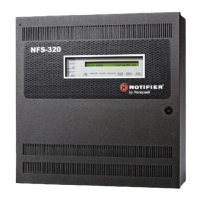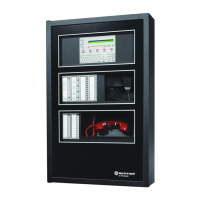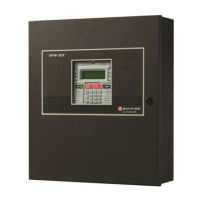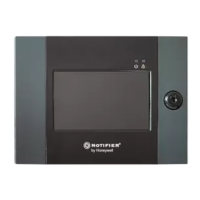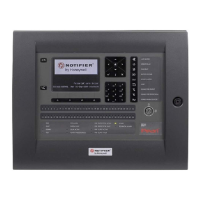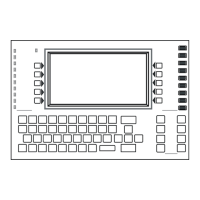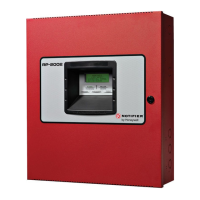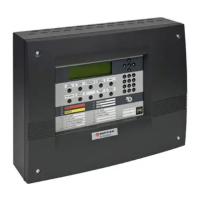NFS-320 and NFS-320SYS UL Listing Document — P/N 52745LD:G9 5/19/2022 19
2. Correct the condition that activated the MN Alarm.
3. Press the
SYSTEM RESET key to return the control panel to normal operation. A “System Normal” message is sent to the LCD display, remote
annunciators, history buffer, installed printers, and CRT-2s.
– Mass Notification Supervisory (If no other events exist on the fire panel)
• Produces a warbling audible tone
• Activates any supervisory relays and devices programmed as Supervisory Pending, General Supervisory and General Pending
• Flashes the
SUPERVISORY LED (yellow)
• Activates Special Zone ZFE
• Sends a MN Supervisory message to the LCD display, remote annunciators, history buffer, installed printers, and CRT-2s.
• Sends a Supervisory message to the central control station via the network, if applicable.
• Displays a type code that indicates the type of MN supervisory alarm being generated
• Displays
MN SUP in the status banner on the control panel, along with information specific to the device as shown below:
– Responding to a MN Supervisory event:
1. Press the
ACKNOWLEDGE/SCROLL DISPLAY key to silence the panel sounder and switch the SUPERVISORY LED from flashing to steady.
An Acknowledge message is sent to the remote annunciators, history buffer, installed printers, and CRT-2s. Pressing the ACKNOWLEDGE/
SCROLL DISPLAY key will acknowledge all MN supervisory events on the fire panel.
2. Correct the condition that activated the MN supervisory point.
3. For a Latching event, press the
SYSTEM RESET key to return the control panel to normal operation.
For a Non-Latching Event, the panel will return to normal operation once the supervisory condition is corrected,
A “System Normal” message is sent to the LCD display, remote annunciators, history buffer, installed printers, and CRT-2s.
– Mass Notification Trouble (If no other events exist on the fire panel)
• Produces a pulsed audible tone
• Activates any trouble relays and devices programmed as General Trouble, Trouble Pending, and General Pending
• Flashes the
TROUBLE LED (yellow)
• Activates Special Zone ZFF
• Displays a Type Code that indicates the type of device with a trouble
• Sends a Trouble message to the LCD display, remote annunciators, history buffer, installed printers, and CRT-2s.
• Sends an Trouble message to the central control station via the network, if applicable.
• Displays
MN TBL in the status banner on the control panel, along with information specific to the device as shown below:
– Responding to an MN trouble event:
1. Press the
ACKNOWLEDGE/SCROLL DISPLAY key to silence the panel sounder and switch the SYSTEM TROUBLE LED from flashing to steady.
An Acknowledge message is sent to the remote annunciators, history buffer, installed printers, and CRT-2s. Pressing the ACKNOWLEDGE/
SCROLL DISPLAY key will acknowledge all MN trouble events on the fire panel.
NOTE: Pressing the SIGNAL SILENCE key when only troubles exist will give the same result as pressing the ACKNOWLEDGE STEP/SCROLL
DISPLAY key. The SIGNALS SILENCED LED does not light unless an alarm exists on the fire panel.
2. Check the trouble message for the location and type of trouble.
3. Correct the condition causing the trouble condition. If the trouble clears, the control panel sends a Clear Trouble message to the History
Buffer and installed printers, annunciators and CRT-2s. (troubles will clear from the fire panel even if the trouble is not acknowledged.)
4. If no other events are present on the fire panel. a “System Normal” message is sent to the LCD display, remote annunciators, history buffer,
installed printers, and CRT-2s and the fire panel returns to normal operation.
• Trouble Event (If a fire alarm exists and alarms are silenced, a trouble event will resound the panel sounder. The fire alarm message will remain
displayed on the LCD display.)
– System Trouble (If no fire alarms exist on the fire panel)
• Produces a pulsed audible tone
• Activates the Trouble relay (TB4)
• Flashes the
TROUBLE LED (yellow)
• Displays a Type Code that indicates the type of device with a trouble
MN SUP ECS/MN SUPL SECURITY STATION
MAIN BLDG Z004 03:19P 041512 2M147
Status Banner
Type Code
Custom descriptor for
this device location
Device address
Time and date of trouble
Zone
Extended 12 character
custom label
Figure 27 Sample MN Supervisory Alarm Message
MN TBL ECS/MN TROUBLE MON SECURITY POST
MAIN BLDG SHORT 03:17P 041512 2M147
Type of Event
Type of device
Custom descriptor for
this device location
Device address
Time and date of trouble
Type of
trouble
Extended 12 character
custom label
Figure 28 Sample MN Trouble Message
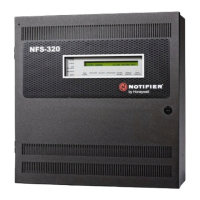
